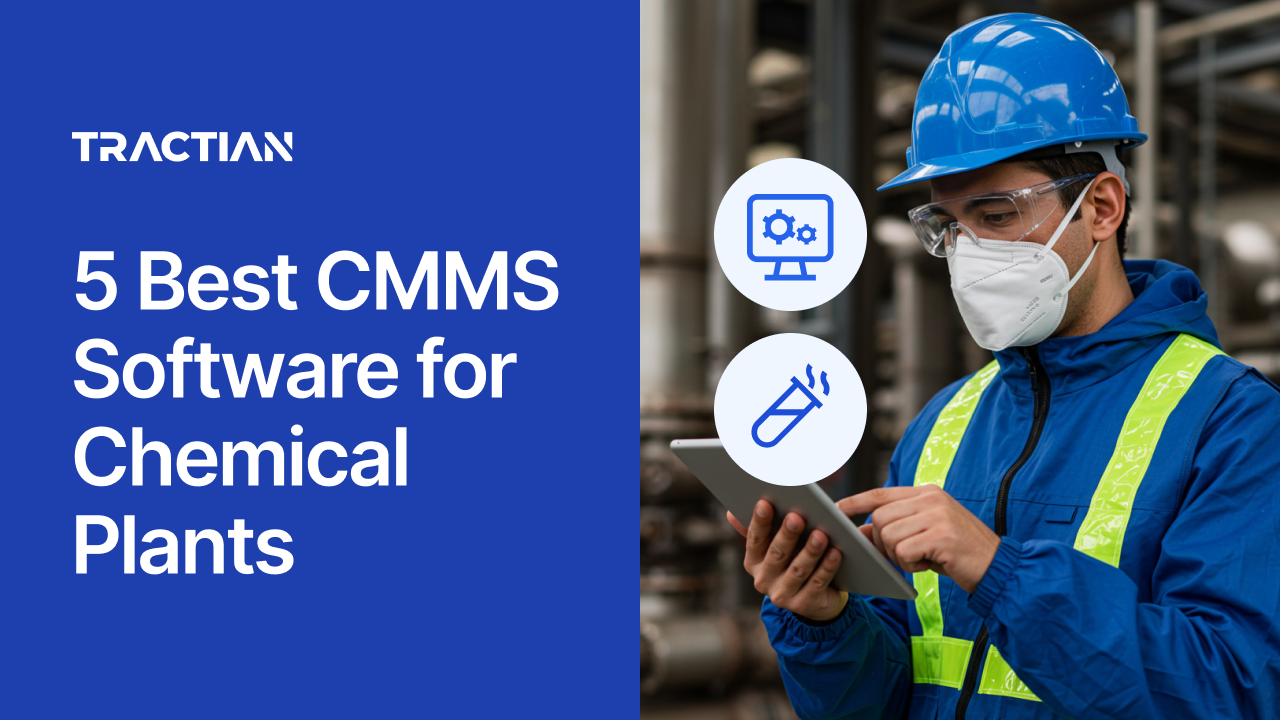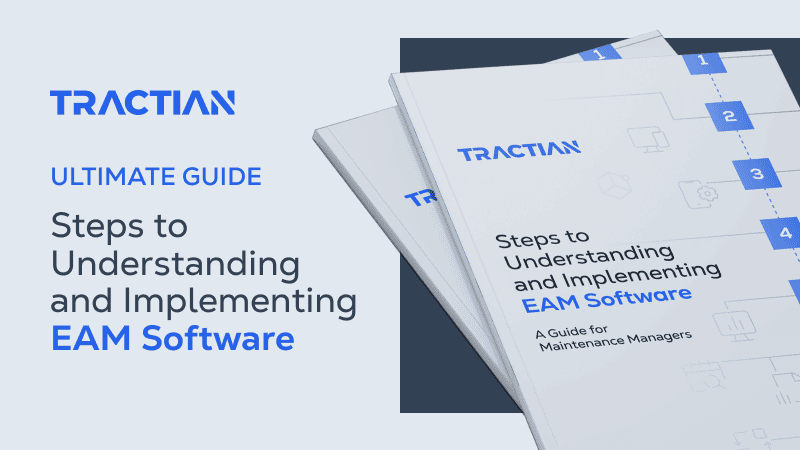Unlike other industries, chemical manufacturing doesn’t forgive maintenance mistakes. The margin for error is razor thin, especially when dealing with pressurized systems, corrosive compounds, and strict regulatory frameworks.
If you’re not in chemical manufacturing but still evaluating CMMS platforms, check out our guide to the 5 Best CMMS Software for maintenance teams.
Whether it's EPA, OSHA, or ISO standards, audits come without warning and violations come with real costs, like fines, shutdowns, lost batches, and reputational damage.
And yet, many teams still rely on fragmented spreadsheets, overcomplicated EAMs, or underused CMMS tools that were never designed for technician adoption or compliance-grade traceability. Maintenance ends up reactive, tribal knowledge stays undocumented, and work orders pile up with no prioritization logic.
That’s why maintenance teams in the chemical sector are moving towards CMMS software built for chemical manufacturing needs, not just to log tasks, but to enforce procedures, track every step, and generate audit-ready records by default.
In this guide, we break down five of the best platforms for that job. Whether you’re managing a single facility or an international operation, these CMMS solutions are engineered to reduce downtime, support regulatory compliance, and protect high-risk processes from avoidable failures.
Why Chemical Maintenance is a Different Game
Maintenance in the chemical industry isn’t just about asset uptime, but also about operational control in one of the most high-stakes environments out there.
Here, every pump, valve, and motor perform a specific function while also holding a safety, compliance, or quality implication. One failure in a neutralization line could mean an environmental incident. One missed SOP on a reactor washdown could ruin an entire production batch. And when you’re dealing with flammables, corrosives, or regulated ingredients, maintenance can’t afford guesswork.
It’s also a documentation-heavy reality. OSHA inspectors don’t want verbal confirmations, they need timestamped logs, technician IDs, completed checklists, and maintenance records aligned with every standard operating procedure. When you can’t produce proof on demand, you’re already out of spec.
That’s why chemical plants need a CMMS that does more than assign tasks. You need a system that:
- Guides execution with embedded procedures and PPE requirements
- Tracks technician activity in real time, both online and offline
- Connects tasks with parts, compliance steps, and post-maintenance validations
- Generates audit-ready logs without extra effort
Whether it’s a planned shutdown or a pump seal change on the fly, the CMMS must act as an extension of your compliance framework instead of just a digital clipboard.
What to Look for in a CMMS for Chemical Operations
In the chemical industry, the most important things when it comes to maintenance are regulatory survival, contamination prevention, and process safety. That’s why the right CMMS must do more than track work orders. It needs to operate like a second set of eyes, one that sees everything, documents everything, and never forgets a step.
Here’s what that looks like on the ground:
Work Order Execution Built for the Floor: Chemical plants aren’t office spaces. Your technicians operate in ATEX zones, around corrosive or flammable materials, often wearing gloves, suits, or respirators. The CMMS needs to be mobile-first, glove-friendly, and fully usable in offline mode, especially in tank farms or remote process areas where Wi-Fi doesn’t reach. If the tech has to write it down and log it later, the traceability is already broken.
Embedded SOPs and Compliance Steps: You’re not just changing a gasket, you’re securing a line under pressure, following lockout/tagout, flushing hazardous residues, and documenting the neutralization step. That entire sequence needs to be embedded in the task, not buried in a PDF or left to memory. The right CMMS forces completion of every required safety and compliance step before a task can be closed, with logs to prove it.
Live KPI Tracking for Risk-Prone Assets: A failed pump in a cooling circuit? A valve stuck open in a solvent line? These aren’t just equipment issues, they’re potential compliance and environmental events. You need real-time insights into MTBF, open backlog, overdue tasks, and failure response times, broken down by line, unit, or technician.
Audit-Grade Documentation: EPA inspections don’t wait for prep time. You need a system that logs technician names, timestamps, full task histories, and even step-by-step execution on preventive inspections tied to your PSM plan. A properly designed CMMS should let you export this proof in seconds, not days. That includes all corrective actions and maintenance logs tied to critical equipment like scrubbers, pressure vessels, and transfer lines.
Parts and Inventory Control Tied to Execution: A part on hold in the warehouse? A missing replacement seal on a reactor valve? That’s how critical tasks get pushed, and how compliance schedules fall apart. Your CMMS should alert you before the part becomes a bottleneck, and link tools, permits, and replacement items directly to the work order. This is especially important in plants operating under strict permit-to-work systems or shutdown schedules.
Failure Mode and Condition-Based Alerts: Chemical wear isn’t always visible. Pump cavitation, seal degradation, micro-leaks in corrosive piping, all build silently. A CMMS connected to sensor data should alert you when vibration thresholds spike, when temperature deltas deviate from normal, or when a machine's failure modes begin to trend. Bonus points if it turns that data into tasks automatically, before you’re dealing with a spill or shutdown.

Now, let's see the best options when it comes to maintenance software for chemical industries:
1. Tractian
Best for: Chemical plants that need mobile execution, SOP enforcement, and instant compliance traceability without the complexity of traditional CMMS platforms.
Tractian is built ground-up for execution in real chemical environments. From PPE-required zones to offline tank farms, our software gives your technicians the power to execute, log, and standardize critical tasks without ever needing to leave the floor or call in backup.
Our AI can track tasks, of course, but it also builds structured SOPs directly from your tribal knowledge. So steps like neutralizing a reactor, flushing a transfer line, or inspecting a failing seal on a caustic pump become standardized, enforced, and traceable.
With offline functionality, mobile-first UX, and sensor-connected diagnostics, Tractian is built to handle the realities of chemical maintenance: frequent inspections, volatile compounds, and the constant pressure of regulatory scrutiny.
Key Features
- AI-generated SOPs for high-risk equipment: Automates inspections, LOTO steps, and chemical handling tasks, forcing step-by-step execution.
- Offline mobile logging: Ideal for hazardous zones, remote storage tanks, and plants with limited connectivity.
- Work orders tied to tools, permits, and inventory: Prevents delays and compliance gaps tied to missing PPE, tools, or replacement parts.
- Live backlog and compliance dashboards: Track overdue PMs, open corrective actions, and audit-readiness in real time.
- Predictive diagnostics with integrated sensors: Detect vibration anomalies, over-temp conditions, or pressure shifts before a failure escalates.
- Fast implementation and data migration: Onboards your SOPs, Excel routines, and asset registry with structured templates and live support.
What Real Customers Say
- “I like that I can track all of our assets from one location. If a motor is having issues in one part of the plant , and then another on the other side of the plant I am able to basically troubleshoot both motors in one location", says Nicholas D., who works as Maintenance Lead Supervisor in an Enterprise.
- “The ease of tracking equipment without having to constantly observe. Tractian does the work for you", says Jordan D., who works as Maintenance Supervisor in an Enterprise.
- “If we're not monitoring our assets in real time, we lose a lot of important operational information. Fortunately, Tractian keeps track of everything for us. We can't imagine working without this tool anymore.”, says Gustavo Nazar, Maintenance Analyst, Yara International
Pricing
- Standard Plan: From $60/user/month (minimum 5 users, billed annually)
- Enterprise Plan: From $100/user/month (minimum 10 users)
- Custom Bundles: Available for combining CMMS with Tractian’s condition monitoring sensors
All plans include mobile offline execution, AI-generated SOPs, full onboarding, training, and Excel-to-CMMS data migration. A free trial is also available.
2. eMaint (by Fluke)
Best for: Teams that want a configurable CMMS with broad compliance support and are already invested in the Fluke ecosystem.
eMaint is designed to digitize maintenance records, centralize asset data, and improve traceability across facilities handling regulated materials and complex processes.
The platform supports customizable workflows and multi-site operations, making it flexible for teams that want to build around their existing SOPs and compliance structure. That said, its flexibility also means a steeper setup curve, especially if you don’t have in-house IT or system integrators.
While it doesn’t enforce SOPs within the task the way newer platforms do, it does allow for checklists, inspection logs, and asset-level documentation.
Key Features
- Custom workflows for compliance routines: Build workflows around your maintenance procedures for tank cleaning, gas detection system checks, or valve integrity testing.
- Asset hierarchy and location-based tracking: Manage complex plant layouts with multi-asset dependencies and nested location tracking, ideal for batch production environments.
- Document control and inspection history: Attach calibration certificates, SDS sheets, and validation records directly to equipment profiles.
- Mobile app support: Allows real-time updates from the floor, though not as streamlined as mobile-first platforms.
- Integrated condition monitoring (with Fluke tools): Pulls data from vibration sensors, thermal imaging, and electrical analyzers into your asset management strategy.
What Real Customers Say
- “The asset selection process is overwhelming for operators. For operators to choose the correct asset from a list of several hundred assets is overwhelming. An asset tree structure or asset hierarchy structure is easy and should be included from the start", says a Verified User in Manufacturing.
- “It's fairly user friendly but still can be clunky", says Ian S., Engineering team leader in Mid-Market.
Pricing
- Essentials Plan: Starts at $33/user/month (includes work order management, preventive maintenance scheduling, and asset tracking)
- Professional Plan: From $85/user/month (adds advanced reporting, document management, and Fluke integrations)
- Enterprise Plans: Custom pricing based on number of users, sites, and required integrations
3. IBM Maximo
Best for: Large chemical manufacturers needing centralized control, validation-ready documentation, and full integration with enterprise systems.
IBM Maximo has good structure, rigid workflows, centralized control, and tight integration with broader enterprise systems. That makes it ideal for large chemical operations where IT governance, compliance reporting, and multi-site consistency are paramount.
But that power comes with complexity. Maximo was built for IT-managed deployment, not floor-level usability. While it’s capable of supporting extensive SOP tracking, it often requires custom modules and configuration to get there. For teams without dedicated admin or support staff, adoption can lag behind, even more so when technicians are working in PPE or across hazardous areas with limited connectivity.
Key Features
- Enterprise-grade asset lifecycle tracking: From commissioning to decommissioning, Maximo logs asset history, maintenance events, and inspection records, ideal for pressure vessels, scrubbers, and critical containment systems.
- Custom workflows and SOP enforcement (via add-ons): Supports regulated SOP processes, though it often requires configuration and training to operationalize on the floor.
- Regulatory and audit-ready reporting: Exports meet standards for OSHA PSM, EPA, and ISO, supporting validation and regulatory submissions.
- Integration with ERP and EHS systems: Seamless data exchange with SAP, Oracle, and safety platforms for procurement, training records, and permit-to-work processes.
- Failure codes and condition tracking: Supports detailed cause coding and analysis for repeat failures on pumps, exchangers, or instrumentation.
What Real Customers Say
- “Even though Maximo is a tremendous Asset management solution, it does not give us flexible features of case management, the change management process is also a bit complicated. The user interface is also not user-friendly”, says Partha Protim P., Product Specialist.
- “It's quite flexible for me, and quite easy to get used to”, says Mohideen R., Head of Equipment & Maintenance.
Pricing
- Core Licensing: Starts around $120/user/month (varies based on module and deployment size)
- Enterprise Suite: Custom pricing based on number of assets, users, and integrations
- Implementation: Typically requires third-party consultants or internal IT support to deploy, configure, and maintain
4. SAP Plant Maintenance (SAP PM)
Best for: SAP-based organizations that need centralized maintenance records, cost tracking, and global audit traceability, but have the internal resources to support complex configuration.
For chemical companies already running SAP ERP, SAP PM is often the default maintenance tool. It’s strong in asset traceability, cost-center alignment, and document control, making it valuable for operations where maintenance is tightly tied to regulatory, financial, or procurement workflows.
But SAP PM wasn’t designed with the technician in mind. Floor-level adoption can suffer due to its rigid UI, lack of mobile-first functionality, and limited support for real-time task execution. Often, tasks are logged after-the-fact or by planners, which weakens your audit trail and delays failure response. Custom extensions or third-party tools are usually needed to bridge those gaps.
Key Features
- Seamless SAP ERP integration: Maintenance tasks are directly tied to procurement, cost centers, training records, and production schedules.
- Structured documentation and audit logs: Supports PSM documentation, equipment certifications, and inspection histories required under OSHA or EPA oversight.
- Customizable notifications and task flows: Enables work order generation based on events like batch changeovers, control system alerts, or quality deviations.
- Permit-to-work and safety documentation: Integrated with SAP EHS (if configured), supports maintenance in high-risk chemical processing areas.
- Global master data and SOP standardization: Enforces uniform asset data, work order templates, and procedures across multiple plants.
What Real Customers Say
- “One of the most critical features of SAP EAM is its tight integration with other modules of the SAP ERP suite", says Nnamdi E., SAP Functional Analyst.
- “It isn't the most visually appealing or user friendly software. You need SAP experience to fully use the program", says a Verified User in Environmental Services.
Pricing
- SAP doesn’t publish standalone pricing for PM. SAP Plant Maintenance is bundled into the broader S/4HANA or ECC enterprise suite, so access depends on your overall SAP licensing agreement. The costs vary widely based on user count, contract tier, and included modules.
- Add-ons and Customization: Mobile capability, SOP enforcement, and floor-level usability usually require additional SAP Fiori apps, third-party add-ons, or in-house development, which can increase cost and complexity significantly.
5. PEMAC Assets
Best for: Regulated chemical sites needing strong audit compliance, risk-based planning, and SOP traceability, especially in GMP, EPA, or ISO-regulated environments.
PEMAC Assets has an out-of-the-box support for validation-heavy environments and EHS (environment, health, and safety) workflows, making it a good fit for plants operating under strict SOP enforcement, permit-to-work procedures, and GMP requirements.
It offers detailed asset hierarchies, condition monitoring, and risk-based maintenance planning.
However, it’s not as intuitive as newer, mobile-first platforms. Floor-level usability can be a challenge, and some features may require IT or vendor support to configure. It’s best suited for organizations that prioritize governance and traceability over speed or low-complexity execution.
Key Features
- EHS and permit-to-work integration: Built-in workflows for isolations, safety assessments, and hazardous work approvals, ideal for batch reactors, flammable storage, or confined space entries.
- Calibration and validation module: Supports instrument calibration and audit trails for pressure gauges, flow meters, and chemical dosing systems.
- Risk-based maintenance planning: Helps prioritize PM tasks based on asset criticality, failure history, and process impact.
- Energy and environmental tracking: Captures energy usage and emissions data for reporting and cost-reduction initiatives.
- Multi-site oversight with SOP standardization: Enforces global procedures while allowing site-specific task execution and reporting.
What Real Customers Say
- “It’s good, but slow”, says Thomas H., a Senior Projects Engineer.
- “Easy to use and user-friendly experience”, says Aaron B., who works in Mid-Market.
Pricing
- Core CMMS Package: Pricing starts at $80–100/user/month (varies by modules and scale)
- Modules for Calibration, EHS, and Energy: Sold as add-ons or bundled per customer configuration
- Deployment: Available as cloud or on-premise; typical rollout includes data migration, workflow configuration, and compliance validation support
CMMS Comparison at a Glance
| Requirement | Tractian | eMaint | IBM Maximo | SAP PM | PEMAC Assets |
|---|---|---|---|---|---|
| Work Order Traceability | ✅ Built-in logs + mobile execution | ✅ Full audit trail | ✅ Robust, IT-configured | ✅ Tied to ERP work orders | ✅ Strong compliance tracking |
| Predictive Maintenance | ✅ Native sensors + AI | ✅ Fluke sensors supported | ⚠️ Requires integration | ⚠️ External modules needed | ⚠️ External tools needed |
| SOP Automation & Governance | ✅ Embedded in every task | ⚠️ Limited SOP structuring | ✅ Via EAM modules | ⚠️ Requires custom builds | ✅ SOPs & risk modules |
| Compliance & Audit Support (OSHA, EPA, ISO) |
✅ Role-based access + export-ready logs | ✅ Strong audit features | ✅ Deep compliance config | ✅ Built-in to ERP ecosystem | ✅ Built for regulatory environments |
| Mobile + Offline Capability | ✅ Native offline support | ✅ iOS/Android, partial offline | ⚠️ Legacy mobile interface | ⚠️ Mobile via Fiori apps (add-on) | ⚠️ Browser-based, limited offline |
| Multi-site Asset Hierarchies | ✅ Real-time across locations | ✅ Full multi-site support | ✅ Deep hierarchy support | ✅ Global standardization | ✅ Designed for multi-plant ops |
| Sensor / SCADA / PLC Integration | ✅ Native sensor stack + API | ⚠️ Requires Fluke + SCADA config | ✅ SCADA/PLC integrations possible | ⚠️ Custom integration required | ⚠️ Limited without external tools |
| User Adoption on the Floor | ✅ Technician-first UX | ⚠️ Mixed (training needed) | ❌ Low without consulting layer | ⚠️ Requires IT support & training | ⚠️ Usable, but dated interface |
| Implementation Time | ⚡ Weeks, zero IT required | ⚠️ Few months with setup | ⏳ 6–12 months, high IT lift | ⏳ Varies; high effort | ⚠️ Moderate, service-dependent |
Why Most CMMS Platforms Fail in Chemical Plants
Most maintenance software looks good on paper. It schedules PMs, stores asset histories, and tracks work orders. But when chemical operations start using them on the floor, gaps show up fast, gaps that lead to missed inspections, compliance headaches, and techs working around the system instead of through it.
Here’s the problem: most CMMS platforms weren’t built for regulated, high-risk environments. They weren’t designed to enforce lockout/tagout steps on a reactor valve, or to track corrosion-related repairs on a caustic pump. They weren’t built for audits where timestamped logs and SOP execution history can be the difference between passing and getting shut down.
In real life, this is what failure looks like:
- Tasks logged days later from memory, or not at all.
- Critical steps skipped because they weren’t embedded in the workflow.
- SOPs stored in binders or PDFs, disconnected from the task.
- Backlogs growing, but no visibility into what’s overdue or falling through.
- Inspectors asking for documentation you can’t produce on the spot.
Worse, traditional platforms often rely on legacy desktop interfaces or require expensive customizations just to match your plant’s safety procedures or validation needs. That’s fine if you’ve got dedicated IT staff and months for configuration, but in chemical plants where downtime carries real cost, you need software that works now and on the floor.
That’s why more maintenance leaders are moving to solutions that do more than digitize records. They want systems that enforce compliance, standardize technician execution, and generate traceability as a byproduct of everyday use.
And there's one clear favorite.
Why Tractian Leads in Chemical Maintenance
Tractian is redefining what CMMS means for chemical operations. While most platforms help you plan and log maintenance, Tractian ensures the work is actually done to spec and that every step is documented in a way that meets regulatory scrutiny.
Every task in Tractian is powered by an embedded SOP. That means no more relying on memory or reference documents. Lockout/tagout procedures, PPE requirements, and neutralization steps, each action is part of the work order itself. A technician can’t close the task without completing the full checklist, so execution aligns with compliance automatically.
Also, the platform is mobile-native and offline-ready, built to operate in hazardous zones where connectivity is unreliable. Whether a tech is inspecting a reactor drain valve in the field or replacing a pressure relief device in a Class I Div I zone, Tractian logs everything in real time, even without internet access.
Tractian CMMS is purpose-built for teams like yours, where execution must be flawless, compliance has no wiggle room, and the cost of downtime isn’t just financial, but also operational and environmental. Whether you’re managing five plants or one batch reactor, Tractian gives you the system-level control to prevent failures before they start.
Want to see how it works on your floor?



